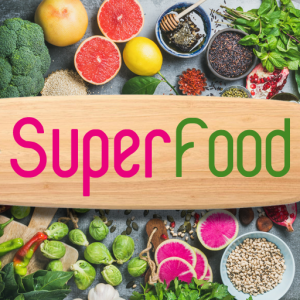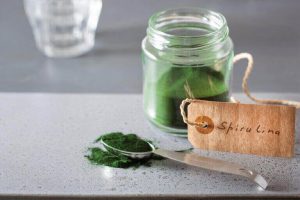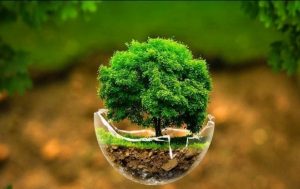Extraction and purification of phycocyanin pigment from spirulina algae
Phycocyanin pigment is obtained from blue-green algae, especially spirulina, and the amount of this substance is about 7-14% of the dry weight of this microalgae, and it is widely used as a natural blue color in different countries. About 50% of the total protein produced by this strain belongs to the phycobiliprotein protein family. Phycobiliproteins are water-soluble colored fluorescent proteins with a complex structure that are obtained from cyanobacteria and eukaryotic algae.
The colored proteins of phycobilisome are placed in three general groups: phycoerythrin, phycocyanin, and allophycosanin, each of which has a different color. Phycobilisomes are a set of light-absorbing antennas in plastic membranes, all of which consist of several protein chains called apoproteins that are covalently attached to phycobilin from the cysteine site. Phycobilin is an open chain tetrapyrrole chromophore. About 20% of the phycobili protein family is related to the valuable protein phycocyanin. Phycocyanin (PC-C) is a blue pigment and light collecting antenna in cyanobacteria and one of the main pigments of cyanobacteria. PC-C consists of two components, protein and chromophore, whose protein part includes two subunits α and β, which have a molecular weight between 18 and 20 kilodaltons.
This water-soluble pigment is widely used in food, cosmetics, and medicine because of its antioxidant, anti-allergenic, and liver-protecting properties and the characteristic of absorbing phycocyanin waves. Also, phycocyanin is used as a fluorescent reagent for diagnostic applications due to its non-toxicity and fluorescent properties. To use natural colors in the food industry, more knowledge is needed about the stability of color conditions and preventing its destruction during the process of industrial production, packaging and storage of colored products. The results of these studies show that the light intensity of 3×105 lux for 24 hours in an aqueous solution with pH = 5 and 7 causes the decomposition of 80% of phycocyanin.
Based on the purity percentage of this pigment, the products or biomass of this algae find many uses as food and medicinal supplements. Improving the production, extraction and purification of phycocyanin can increase its scope of application.
Instructions for extraction and purification of phycocyanin pigment in spirulina microalgae
3-1 – Characteristics of spirulina culture medium
The most important principle in the development of the commercial production process of microalgae on a large scale is to increase the production of biomass and raw material. The growth of microalgae is influenced by various physical (light, temperature and pH) and chemical (macro and micro elements as nutrients). In this technical knowledge, the common food environment for spirulina was used, and it is obvious that the optimization of the environment and culture environment conditions have an effect on the growth rate of the strains used and the production of phycocyanin. It has an effect. The best cultivation environment for the growth of spirulina algae is the field environment, temperature 28 degrees Celsius, light 200-400 and pH = 9
It is recommended with adequate ventilation. which is suitable for any strain with the necessary modifications.
In order to extract phycocyanin from spirulina algae, the cell wall of the microorganism must be broken first. Color extraction from blue-green algae is somewhat difficult due to the resistant cell wall and small cell size. There are various methods to break the cell wall and release phycocyanin from the cell. On a commercial and large scale, there is a need for simple, efficient, effective and cost-effective methods for the isolation of phycocyanin. The steps of the phycocyanin extraction process are explained in the figure below.
Cell destruction and separation stage
To break the cell wall, various methods are used, such as using physical processes such as osmotic shock, freezing at -20 degrees Celsius and returning to 4 degrees Celsius in several stages, sonication or using a press machine, or chemical methods such as using enzymes, detergents, acids. And there are buffers. According to the observations among the mentioned methods, the use of buffer in the extraction obtained better results due to maintaining the protein nature of phycocyanin and its less degradation under these conditions. In the buffer extraction method, an experiment was first designed to determine the type of buffer in which potassium phosphate buffer showed better results in terms of purity and amount of phycocyanin compared to sodium citrate and sodium phosphate buffers. Therefore, this buffer was chosen as the best extraction solution. Different buffer concentrations (water, 50 mM buffer and 100 mM potassium phosphate buffer) were mixed with a specific ratio of biomass, and the extraction process was carried out according to the results obtained from the experiments carried out in different periods of time, for 4 hours with a mixer at a speed of 220 m Then the samples are centrifuged at 18,000 g for 15 minutes and after this step, the upper part (impure phycocyanin) is separated.
The first separation and purification step
The purification stage is one of the most important stages of phycocyanin production. 50 to 90 percent of the costs related to the production of this color are related to its purification steps. Improving the production, extraction and purification of phycocyanin can increase its scope of application.

Based on the purity percentage, this pigment finds many uses as food color, food supplement and medicine. Purification of this substance after the production of raw extract seems necessary for use in food industry. Materials such as ammonium sulfate, chitosan, activated charcoal and polyethylene glycol are used to purify phycocyanin.
Polyethylene glycol and ammonium sulfate are both toxic substances, which causes the process time in this method to be very long, and considering that these substances are combined with phycocyanin, it is very difficult to separate them from each other. Also, the results of the experiments showed that the use of ammonium sulfate for a long period of one or two days requires that this process denatures the phycocyanin protein and reduces its activity. Chitosan is a combined polymer of glucosamine and N-acetylglucosamine, which are connected by 1 and 4 glycosidic bonds. Chitosan has attracted much attention due to its non-toxicity, high absorption property, antibacterial and antitumor properties, the possibility of decomposition in nature, compatibility with the natural environment, relatively low price, the ability to remove a wide range of colors and metals, fast kinetics, and finally, the possibility of preparing many derivatives from it. Today, it is used in various industries such as biotechnology, pharmaceutical and medicine, sewage treatment, cosmetic and food industries.
The fact is that the explanation of extracting phycocyanin from spirulina algae can be a little complicated, but its practical explanation is relatively easier, so those interested can contact Rojab Pars Algae for more information and get to know the production process closely.
contact us










